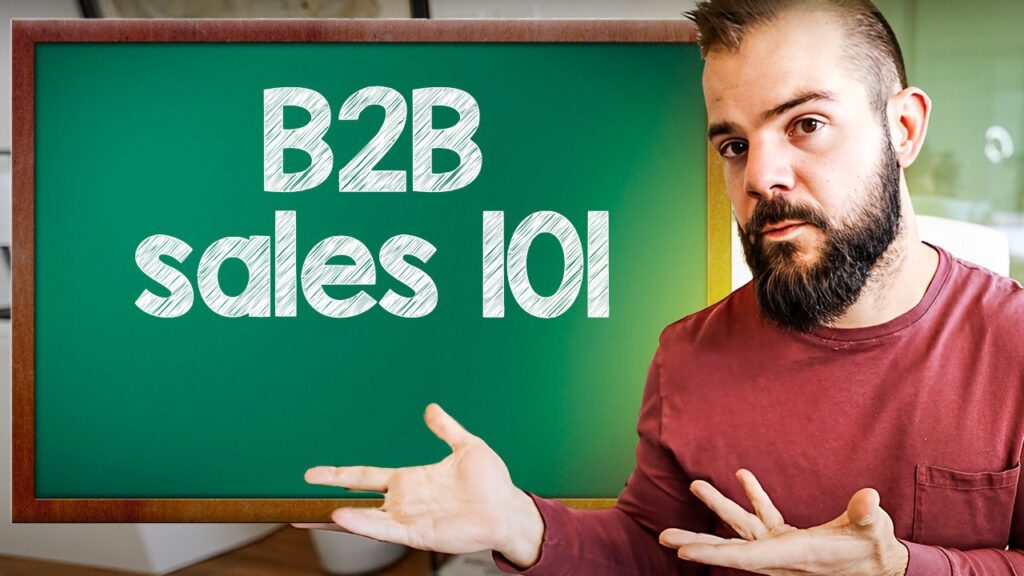Selling to businesses is different than selling direct to consumers.
Dive into this crash course to discover exactly how B2B sales differ from B2C sales, the most effective B2B selling techniques, and much more.
What is B2B Sales?
B2B sales is selling to another business instead of dealing with direct consumers. Such deals typically involve high-value transactions, longer sales cycles, more decision-makers, and a more complex sales process.
Types of B2B Sales
There are three primary types of B2B sales: supply, distribution, and services/software sales. Let’s take a quick look at each of them.
Supply Sales
Supply sales happen between a business and a product supplier. The supplier sells products that support the operations of the purchasing company. Possible examples of supply sales include the purchase of factory supplies, safety equipment, or raw materials.
Wholesale/Distribution Sales
Here, a manufacturer or wholesaler supplies goods in large quantities to another business, retailing those products. The relationship between FMCG manufacturers and supermarkets falls in this category.
Services/Software Sales
This category of B2B sales involves one business offering a service to another company. This could be a one-time deal or a recurring transaction. Examples include service providers like law firms, software, and SaaS (software-as-a-service) businesses, hiring and recruitment agencies, or sales and marketing agencies.
How B2B Differs from B2C Sales
Yes, B2B and B2C sales deal with humans. But that’s where the similarity ends.
1. B2B Sales Includes More Decision Makers
When selling B2C, you usually have to think about only one or two decision-makers. But the number of potential stakeholders jumps to 6-10 in a B2B context, per a study by Gartner.
Purchase decisions in a B2B context have wide-reaching consequences that affect more than the final user(s) of the product or service within the organization. This means many people must weigh in to ensure the purchase decision is best for the business.
2. Longer Sales Cycles and Timelines
A sales cycle is the total time it takes to turn a lead into a customer. B2B sales cycles are typically much longer because they involve more decision-makers.
Several people from the purchasing organization might need to be brought into the sales process at various points.
This can slow down the sales process and make it harder to get to a “yes.”
That’s why 74.6% of B2B sales are closed in at least four months, and 46.4% require seven months or more. On the other hand, B2C deals can be done in minutes or days, especially if the prospect is the only decision-maker.
3. Larger Average Transaction Value
B2B sales often involve complex products or services with a high price point or simple products delivered in large quantities. This makes the value of an average B2B transaction way higher than a B2C deal.
B2B deals can easily rise to thousands or millions of dollars, while you only see this in a limited number of B2C industries such as luxury, housing, and automobile.
4. B2B Sales see more Savvy Buyers
Today’s customers often do research when scouting for products or services, especially online. But the nature, value, and implications of B2B deals make buying groups in this category even more meticulous with research.
A study by Gartner measured the time buying groups spend on key buying activities. It found out that B2B customers spend:
– 27% of the time researching independently online
– 18% of the time researching independently offline
– 22% of the time in meetings
– 17% on meeting with potential suppliers and 16% on other activities.
This research time often translates to a B2B buyer who understands their needs. And a fair idea of what a fitting solution MUST look like.
5. Smaller Total Addressable Market (TAM)
B2C companies can target multiple audience segments and sub-segments. But the total addressable market for B2B products and services is often much smaller.
Also, due to a more complicated sales process, the cost of acquiring a B2B customer is usually higher than in a B2C setting.
6. Longer Customer Lifetime
B2B customers take their time to do due diligence before investing in a product or service provider. As such, B2B sellers often hold onto their customers longer than B2C enterprises.
Longer-lasting customer relationships make up for the small pool of prospects available to B2B businesses. And a larger target market offsets some of the effects of a shorter duration of customer interaction in a B2C setting.
An Overview of the B2B Sales Process
1. Prospecting
The first step in the B2B sales process is finding the right prospects. There are mainly two ways to do this: outbound and inbound prospecting or lead generation.
Outbound lead generation means the business reaches out to prospective clients that fit their ideal customer profile through:
- Cold emails
- Social selling
- Cold calls and more
Inbound lead generation, on the hand, is when businesses attract prospects through marketing methods such as:
- Content marketing
- Organic social media interactions
- Paid ads
- And search engine optimization
In both types of lead generation, leads need to be qualified using a set of criteria to determine which would most likely convert to customers.
2. Research
Next up should be a coordinated approach to get enough information to interact with the prospect. This helps you discover facts that help shape your pitch and establish rapport during the pitch.
It’s best to split your research process into industry and prospect research.
With industry research, you want to dig into the landscape and trends of the prospect’s industry.
Get a sense of their target audience, competitors, offerings, and every detail you’ll need to qualify and connect with the prospect during the sales call or demo.
Prospect research requires you to zoom in and focus on your prospect’s needs.
Find out the key problems they are trying to solve and how much these problems could be costing that particular company.
Using the information you get, you can create a list of case studies involving past or current clients similar to the prospect. These case studies show how your solution could solve the prospect’s issues.
3. Connect/Initial Outreach
Upon first contact with the prospect, your biggest goal should be to qualify them further. B2B customer acquisition can be pricey. And you don’t want to waste time pursuing a lead that’s not a good fit.
Throw in open-ended questions to uncover the company’s goals and current priorities so you can get a sense of where your solution might fit in. Then find out the steps they’ve taken in the past to achieve those goals and the roadblocks they hit in the process.
The insights you uncover will help you craft a tailored pitch and anticipate possible objections.
Here are some questions to ask:
- What problems are you looking to solve?
- How have past solutions let you down?
- What do you expect from a new solution?
4. Pitch/Demo
When you’re satisfied that you’re speaking to the right person, you want to lay out your pitch. This should be focused on the customer’s needs and goals, clear, and compelling. It should also anticipate and handle common objections.
We can run through a list of generic tips for crafting a sales pitch. But in reality, your pitch is only as strong as the impression you’ve made on the prospect during the interactions leading up to that moment.
In other words, you should start your conversation with the end (pitch) in mind. Take the prospect on a journey that primes them for your pitch so that they are ready to close themselves when it finally arrives.
5. Conversion/Closing
Everything you’ve done has been to bring the conversation to where it ends in a sale.
This part of the sales process requires you to lay out your proposal, settle your pricing, finalize terms and conditions, and shake hands on the deal.
Depending on your process, you may also need to follow up with the prospect to get them over the line or offer continuous support to make sure they get the result you promised them.
B2B Selling Techniques that Work
The right B2B selling techniques increase your conversion rate, increase revenue, and drop your customer acquisition cost in the long run.
Here are the four most effective ( and tested) techniques you can start practicing to improve your close rates.
1. Apply SPIN Selling
Neil Rackham’s SPIN selling model stands for situation, problem, implication, and need/payoff questions. It’s an excellent guide for asking the right questions during the sales meeting with prospects.
- Situation: Ask questions that explore why the prospect is searching for a product or service like yours. You want to uncover specific details about where they stand. Ask questions such as “how do you currently do X?” “How important is Y to your business?”
- Problem: While situation questions might uncover some answers regarding the lead’s problems, stage two is where you double down to understand those problems. The goal is to get clarity and prompt the prospect to emphasize their pain points unconsciously. Questions in this category may include “how much is this costing you now?” and “how long does it take to do this?”
- Implication: Here, you involve the lead by uncovering the consequences of the problem and, by extension, of inaction or delayed action. What’s the prospect currently losing? How is the problem setting their business back?
- Need payoff: Questions in this segment will help your leads to acknowledge the value of your product or service and how it can significantly improve their situation. Say, “how much would something like this (describe your solution) save you?”
2. Sell Outcomes
This sounds like a no-brainer. But it’s easy to be caught up in the nuts and bolts of your product or service. In reality, your product’s features are relevant only to the degree that they solve your prospect’s problems. And it’s this sort of relevance that prospects want to hear.
So don’t forget to tie everything back to “what’s in it for me?”
In answering this question, be as specific as possible. Customer success stories and statistics about your track record in getting results will serve you well.
3. Invest in Content Marketing
On the one hand, B2B buyers spending more time on research and less time in contact with sales reps shifts the power dynamics in their favor. But on the other hand, it presents businesses with the opportunity to influence buyer decisions through content marketing.
As of 2018, 76% of B2B buyers reported that their purchase decisions were significantly swayed by quality content. 73% said the winning vendor demonstrated a “stronger knowledge of their company and needs.” 66% claimed that the winning vendor showed a “stronger knowledge of the solution area and the business landscape.” 65% said the vendor provided “informational content that was easy to consume,” and 61% said their preferred B2B vendors offered “higher-quality content.”
If content was a big deal for B2B customers in 2018, best believe it’s even more influential in the buying process now.
Investing in quality content makes it easy for these people to find your business during their research process, and you give yourself the chance to make an impression even before you connect with them one on one.
4. Leverage Social Selling
For B2B sales, social selling involves generating leads, filling your pipelines, and even closing deals on social media. This has become common practice as more and more people connect via social media for business, professional, and social purposes.
Platforms such as Linkedin and Twitter present sales reps with the opportunity to build relationships with prospects via direct contact and intelligent use of content. They also let you position yourself as an expert and attract, intrigue, and connect with decision-makers.
Develop a plan on how you look to drive relevant conversations about your industry on social media and also follow up with people who engage with your content.
Slowly, you begin to build relationships and generate leads that will be more receptive to your sales advances or even reach out to you on their own when the time is right.
Sell Like a Pro
It’s important not to get too hung up on categorizations. Ultimately, B2B and B2C businesses sell to humans. Each business type has its nuances.
The good news is there are rules of thumb to succeed at B2B sales. Master the first principles of selling, keep the context in mind, ensure you’re big on research, and pay attention to the specific needs of each business because all businesses — even those in the same markets — are different in their own ways.

Aaron Martinez is a remote closing expert, content creator, and the face of The Remote Closing Academy. Since 2013, he’s started and grown YouTube channels to hundreds of thousands of subscribers, ran a digital marketing agency, and had a ton of success as a remote closer. Now, his focus is teaching you how to master sales so you can increase your earning potential and do more fulfilling work.



